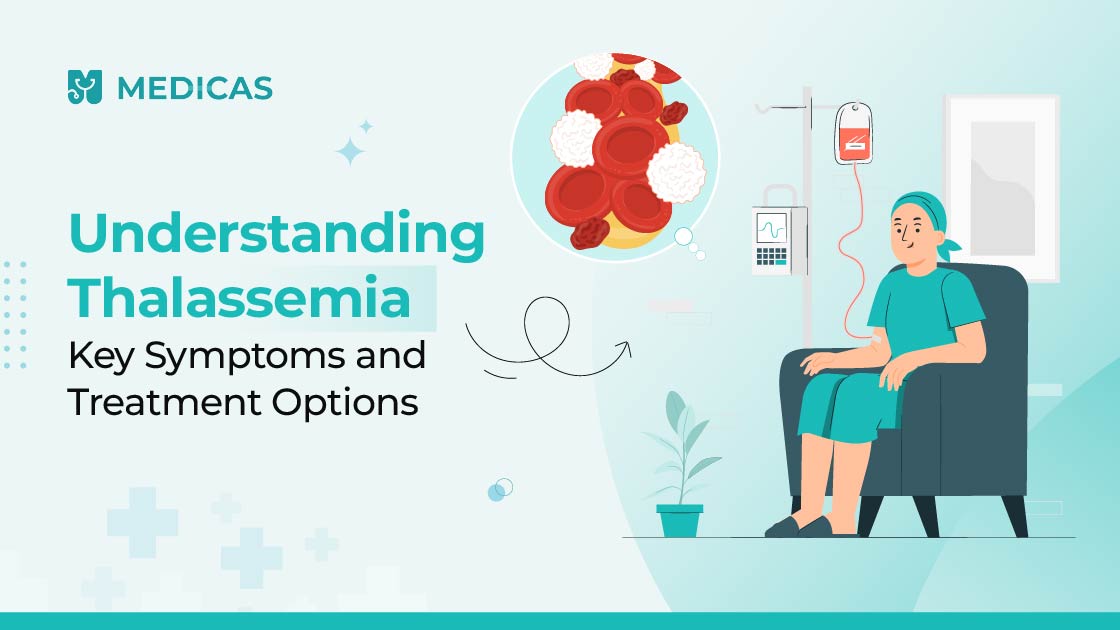Why does a child look pale, feel tired all the time, or fall sick often, despite eating well and getting enough rest? These signs are easy to overlook but can sometimes indicate thalassemia, a disorder that affects how the body produces haemoglobin. Many families don’t realise they carry the gene until symptoms appear or show up in a routine blood test. The condition may seem overwhelming, but with the right knowledge and care, it can be effectively managed. Let’s explore the key symptoms and available treatment options.
What Is Thalassemia?
Thalassemia is an inherited blood disorder in which the body makes an abnormal form of haemoglobin. Haemoglobin is the protein in red blood cells that carries oxygen from your lungs to tissues throughout your body. When haemoglobin is faulty, your body struggles to get the oxygen it needs.
How Thalassemia Affects the Body
Thalassemia doesn’t just affect the blood; it sets off a chain reaction throughout the body. Here’s how this condition disrupts normal processes and why its effects go far beyond just haemoglobin levels.
- Reduced Red Cell Lifespan: Normal red blood cells live about 120 days. In thalassemia, they break down sooner, causing chronic anaemia.
- Bone Marrow Overdrive: To compensate, the bone marrow works extra hard, sometimes causing bone deformities and an enlarged spleen.
- Iron Overload: Frequent blood transfusions, a common component of many thalassemia management plans, can lead to excess iron, which requires its treatment.
Types of Thalassemia
There are different types of thalassemia, depending on which part of the haemoglobin molecule is affected, the alpha or beta chains.
Alpha Thalassemia
In this type, the body has difficulty producing alpha globin chains. Depending on how many of the four alpha genes are faulty, the severity varies from silent carrier to severe anaemia:
| Number of Faulty Genes | Type | Symptoms |
| 1 | Silent Carrier | No symptoms |
| 2 | Alpha Thalassemia Trait | Mild anaemia |
| 3 | Haemoglobin H Disease | Moderate to severe anaemia |
| 4 | Alpha Thalassemia Major | Usually fatal in the womb or shortly after birth |
Beta Thalassemia
Here, the issue lies in the production of beta globin chains. Severity depends on whether one or both beta genes are affected:
| Genes Affected | Type | Symptoms |
| 1 | Beta Thalassemia Minor | Usually, no symptoms or mild anaemia |
| 2 | Beta Thalassemia Major (Cooley’s Anaemia) | Severe anaemia requiring regular transfusions |
Thalassemia Major vs. Minor – Key Differences
Understanding the distinction between thalassemia major vs. thalassemia minor is crucial for prognosis and management.
| Feature | Thalassemia Major | Thalassemia Minor |
| Genetics | Inherits two abnormal beta genes (one from each parent) | Inherits one abnormal beta gene |
| Severity | Severe anaemia requiring regular transfusions | Mild or no anaemia, often asymptomatic |
| Onset of Symptoms | Within the first two years of life | Usually picked up on routine blood tests |
| Growth & Development | Delayed growth, possible bone deformities | Normal growth and development |
| Management | Lifelong transfusions + chelation therapy | Often, no treatment is needed |
Causes of Thalassemia
The causes of thalassemia are purely genetic. It’s not something you can catch or develop later in life due to environmental factors.
Genetic Inheritance and Risk Factors
Thalassemia is passed down in families. If both parents carry a thalassemia trait, there is a 25% chance that their child will have thalassemia major. Carriers (individuals with one abnormal gene) typically exhibit no symptoms but can still pass the trait on.
Who Is at Risk?
Thalassemia is inherited, but some people are at higher risk than others:
- Children born to parents who are both carriers
- Communities with high consanguinity (e.g., cousin marriages)
- Certain ethnic groups, including South Asians, Middle Easterners, and Mediterraneans
Thalassemia Symptoms
The severity and thalassemia symptoms vary depending on the type. It can sometimes go unnoticed till later in life or present early in infancy.
Common Symptoms in Adults and Children
Across all forms of thalassemia, you may see:
- Chronic Fatigue: Persistent tiredness even after rest.
- Pallor: Noticeably pale skin and palms.
- Shortness of Breath: Especially with activity.
- Enlarged Spleen or Liver: Causing discomfort or a feeling of fullness.
- Bone Pain: From marrow expansion.
- Dark Urine: Also a sign of red blood cell breakdown.
- Heart Problems: Such as an irregular heartbeat (arrhythmia) or heart failure, often due to iron overload in severe cases.
Early Signs of Thalassemia in Children
Parents may notice some early signs of thalassemia in children within the first few months to years of life:
- Poor feeding
- Slow weight gain or delayed growth
- Irritability
- Pale appearance
- Repeated infections
Thalassemia Diagnosis
The good news is that thalassemia diagnosis is relatively straightforward with the right tests.
Blood Tests and Genetic Screening
Accurate Thalassemia diagnosis relies on:
- Complete Blood Count (CBC): Shows low haemoglobin and abnormal red cell indices.
- Haemoglobin Electrophoresis: Confirms the type of globin chains present.
- Genetic Tests: Identify specific gene mutations that are crucial for family planning.
Prenatal Diagnosis
Couples with known carrier status can opt for:
- Chorionic Villus Sampling (CVS) at 10–12 weeks.
- Amniocentesis at 15–20 weeks.
These tests can detect thalassemia disease in the unborn baby, helping parents prepare for necessary steps.
Treatment Options for Thalassemia
While there’s no simple pill that cures thalassemia, modern medicine offers several thalassemia treatment paths:
| Treatment Option | Purpose |
| Regular Blood Transfusions | Maintain haemoglobin levels |
| Iron Chelation Therapy | Prevent iron overload from transfusions |
| Folic Acid Supplements | Help red blood cell production |
| Bone Marrow Transplant | Currently, the only curative approach is so, can thalassemia be cured? Yes, in select patients with a matched donor. |
| Splenectomy | In case of a very enlarged spleen |
Conclusion
Thalassemia is a genetic blood disorder that, with proper management, can be effectively controlled. From early diagnosis to ongoing care, managing thalassemia requires a collaborative effort among the patient, their family, and healthcare providers. Today, improved awareness, better therapies, and support make it possible for individuals with thalassemia to lead full, productive lives. For expert guidance, consider online doctor consultation through Medicas, a trusted platform where you can book appointments, book lab tests, and even explore safe home remedies under professional supervision. Take control of your health journey with Medicas by your side.
Frequently Asked Questions (FAQs)
-
What are the main symptoms of thalassemia?
Major signs include chronic fatigue, pallor, shortness of breath, jaundice, and an enlarged spleen. In children, look for poor growth and irritability.
-
Is thalassemia a lifelong condition?
Yes, most types require lifelong care, especially thalassemia major. With regular treatment and monitoring, many patients live well into adulthood.
-
How is thalassemia diagnosed?
Diagnosis involves blood tests, a complete blood count (CBC), and haemoglobin electrophoresis, as well as often genetic screening. Prenatal tests can detect thalassemia before birth.
-
Can people with thalassemia live a normal life?
With modern thalassemia management, many lead healthy, active lives, attending school, working, and starting families, especially when diagnosis and treatment begin early.
-
What foods should thalassemia patients avoid?
Thalassemia patients should avoid foods rich in iron, such as red meat, liver, and iron-fortified cereals, to prevent iron overload.
Disclaimer
Medical Advice: The information provided in this blog post is for educational purposes only and should not be considered as a substitute for professional medical advice, diagnosis, or treatment. Always consult with a qualified healthcare professional for personalized guidance regarding your specific medical condition.
Accuracy of Information: While we strive to provide accurate and up-to-date information, the field of medicine and viral fevers is constantly evolving. The content in this blog post may not reflect the most current research or medical guidelines. Therefore, it is advisable to cross-check any information provided with reliable sources or consult a healthcare professional.
Individual Variations: The symptoms, causes, treatment options, and preventive measures discussed in this blog post are general in nature and may not apply to everyone. It is important to remember that each individual’s situation is unique, and personalized medical advice should be sought when making healthcare decisions.
External Links: This blog post may contain links to external websites or resources for additional information. However, we do not endorse or have control over the content of these third-party websites. Accessing these links is done at your own risk, and we are not responsible for any consequences or damages that may arise from visiting these external sources.
Results May Vary: The effectiveness of treatment options or preventive measures mentioned in this blog post may vary from person to person. What works for one individual may not work the same way for another. It is essential to consult with a healthcare professional for personalized advice tailored to your specific needs.

Dr. Aesha Bhatt is a dedicated General Physician with over 4 years of clinical experience in delivering comprehensive primary care. Based in Vadodara, Gujarat, she holds an MBBS degree and is registered with the Gujarat Medical Council. Dr. Bhatt is committed to providing holistic, evidence-based medical care, with a focus on managing common acute and chronic conditions. Known for her patient-first approach and strong diagnostic acumen, she is passionate about preventive healthcare, patient education, and building long-term trust with those she serves.


